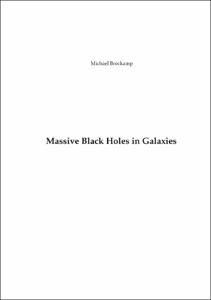Brockamp, Michael: Massive Black Holes in Galaxies. - Bonn, 2014. - Dissertation, Rheinische Friedrich-Wilhelms-Universität Bonn.
Online-Ausgabe in bonndoc: https://nbn-resolving.org/urn:nbn:de:hbz:5n-37807
Online-Ausgabe in bonndoc: https://nbn-resolving.org/urn:nbn:de:hbz:5n-37807
@phdthesis{handle:20.500.11811/6185,
urn: https://nbn-resolving.org/urn:nbn:de:hbz:5n-37807,
author = {{Michael Brockamp}},
title = {Massive Black Holes in Galaxies},
school = {Rheinische Friedrich-Wilhelms-Universität Bonn},
year = 2014,
month = oct,
note = {After summarizing the current status of black hole related research, I investigate the angular momentum driven flux of stars onto supermassive black hole (SMBH) loss cone orbits by means of direct NBODY6 computations. By performing a large parameter study with different SMBH capture radii and particle numbers ranging from N=1e3 to N=0.5e6, the influence of dynamical effects on the tidal disruption rate of stars is explored. These dynamical effects are the Brownian motion of the SMBH, cusp formation and dynamical heating. Afterwards, the tidal disruption rate is computed by scaling these numerically obtained results to astrophysical galaxies hosting central massive black holes. I found that angular momentum driven diffusion is insufficient to influence the growth of SMBHs which are more massive than 1e6 M_sun. However, the expected rate can be used to unveil black holes in the intermediate black hole mass regime (1e3-1e5 M_sun) owing to a tidal disruption rate which only weakly depends on the black hole mass.
In this PhD thesis I also present a new versatile software code (MUESLI) designed for the purpose of computing the evolution of globular cluster systems (GCSs) around elliptical galaxies. MUESLI is based on the self-consistent field method in combination with the time-transformed Leapfrog scheme and applies various internal (e.g. relaxation) and external physical dissolution processes (e.g. triaxial dynamical friction) on each globular cluster. It is found that erosion can explain the absence of globular clusters around the compact elliptical galaxy M32. Furthermore, erosion can explain the transition of a single power law into bell-shaped cluster mass function as well as the observed cores in the number density profiles of globular cluster systems. MUESLI-based computations indicate that the observed core size should depend on the imposed cluster threshold mass/luminosity as long as erosion is the primary process. In principle this allows to discriminate (observationally) between different GCS formation theories. I also found evidence for a new phase in the dynamical evolution of entire globular cluster systems where tidal shocking dominates over other dissolution mechanisms. For this reason I named this phase the tidal disruption dominated phase (TDDP). The TDDP is followed by a less violent relaxation driven mass loss phase.
Finally, the implementation of a relativistic black hole into MUESLI is documented and tested. This feature allows to study the growth of SMBHs from cluster debris or stars on centrophilic orbits.},
url = {https://hdl.handle.net/20.500.11811/6185}
}
urn: https://nbn-resolving.org/urn:nbn:de:hbz:5n-37807,
author = {{Michael Brockamp}},
title = {Massive Black Holes in Galaxies},
school = {Rheinische Friedrich-Wilhelms-Universität Bonn},
year = 2014,
month = oct,
note = {After summarizing the current status of black hole related research, I investigate the angular momentum driven flux of stars onto supermassive black hole (SMBH) loss cone orbits by means of direct NBODY6 computations. By performing a large parameter study with different SMBH capture radii and particle numbers ranging from N=1e3 to N=0.5e6, the influence of dynamical effects on the tidal disruption rate of stars is explored. These dynamical effects are the Brownian motion of the SMBH, cusp formation and dynamical heating. Afterwards, the tidal disruption rate is computed by scaling these numerically obtained results to astrophysical galaxies hosting central massive black holes. I found that angular momentum driven diffusion is insufficient to influence the growth of SMBHs which are more massive than 1e6 M_sun. However, the expected rate can be used to unveil black holes in the intermediate black hole mass regime (1e3-1e5 M_sun) owing to a tidal disruption rate which only weakly depends on the black hole mass.
In this PhD thesis I also present a new versatile software code (MUESLI) designed for the purpose of computing the evolution of globular cluster systems (GCSs) around elliptical galaxies. MUESLI is based on the self-consistent field method in combination with the time-transformed Leapfrog scheme and applies various internal (e.g. relaxation) and external physical dissolution processes (e.g. triaxial dynamical friction) on each globular cluster. It is found that erosion can explain the absence of globular clusters around the compact elliptical galaxy M32. Furthermore, erosion can explain the transition of a single power law into bell-shaped cluster mass function as well as the observed cores in the number density profiles of globular cluster systems. MUESLI-based computations indicate that the observed core size should depend on the imposed cluster threshold mass/luminosity as long as erosion is the primary process. In principle this allows to discriminate (observationally) between different GCS formation theories. I also found evidence for a new phase in the dynamical evolution of entire globular cluster systems where tidal shocking dominates over other dissolution mechanisms. For this reason I named this phase the tidal disruption dominated phase (TDDP). The TDDP is followed by a less violent relaxation driven mass loss phase.
Finally, the implementation of a relativistic black hole into MUESLI is documented and tested. This feature allows to study the growth of SMBHs from cluster debris or stars on centrophilic orbits.},
url = {https://hdl.handle.net/20.500.11811/6185}
}






